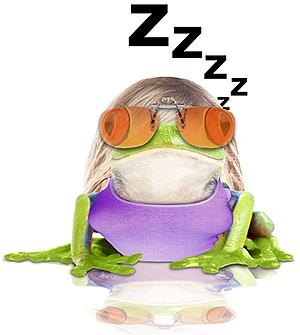May 2015: There are a ton of apps and wearables for tracking or analyzing sleep — but what about devices that actually help you get the Zs you need?
The blue wavelengths in light emitted by our many screens — smartphones, tablets, TVs, computers — reduces production of melatonin, the hormone that regulates your sleep cycle. So if you can’t give up your screen(s) at night, try these anti-blue solutions to help you sleep better and leap further in the morning:
- Wear glasses that block blue light. BluBlocker is one of the most popular lines of amber-lens glasses that filter out blue light. Amber lenses also filter out green light, the other melatonin-reducing wavelength. Gunnars and Duco Optics use yellow lenses to block the blue and some experts say you can even wear super-cheap red safety glasses that will keep blue at bay. Do you already wear glasses? Try clip-ons or a pair that fits over your regular glasses. You might think you look silly but your morning self will thank you.
- Put blue-blocking filters on your screens. Try putting the lenses on your devices instead of your eyes. Sleep Shield, for example, offers anti-blue screen protectors for Apple and Samsung smartphones, Apple and Kindle tablets and MacBook laptops. LowBlueLights has them for TVs in a variety of sizes. A do-it-yourself version is to get a sheet of rubylith (clear red plastic), cut it to size and stick it to your computer monitor with tape or Velcro buttons. Addicted to middle-of-the-night smartphone sessions? Keep a filter on your bedstand.
- Get an app that turns blue tones red. Since your device screens are made to mimic the light of the sun at high noon, why not have them mimic sunlight as the day progresses instead? F.lux, a free app for Windows, Mac, Linux and iPhone/iPad, adjusts your screen’s color to the time of day and the kind of light you have in the room. So in the morning it triggers your brain to wake up and stay active. And when it gets close to bedtime? Bye-bye blue!
- Get some bulbs that emit less blue light. You can buy bulbs that reduce or eliminate blue light but leave other wavelengths intact. Try LowBlueLights (mentioned above) or Good Night LED lights. Using regular red (or orange) bulbs can help, too — red light suppresses melatonin the least. TCP has a line of colored bulbs available at Amazon.com and The Home Depot for about $5 each. Just turn on those bulbs a couple hours before you want to go to bed to help your brain get ready to sleep despite the screens that may still be on.
- Use multi-colored smart bulbs. Light bulbs you control from a smartphone app is changing the purpose of lighting in your home. Want your body to respond a certain way? Change the light! Your bulbs are now a tool you can use to control the color and intensity of each light fixture in your house. They aren’t cheap but most last around 15,000 hours and who knows how much they can pay off in increased productivity — and well-being. LG, Samsung and PhilipsBolt smart bulbLIFXNest offer smart bulbs and the from Misfit coordinates with its sleep tracker app. The bulbs from LIFX also works with Nest smart home technology.
Do you want to complement your anti-blue light pursuits? Try a meditation app from Healthline (iPhone and Android), Lifehacks (iPhone) and Android Headlines (Android) — or other sources (there are tons). And, of course, remember the standby analog tips that are so easy to forget when we’re busy staring at screens:
- Go outside and expose yourself to sunlight each day (it still counts if it’s cloudy)
- Dim or turn off your lights one to two hours before before you want to go to bed
- Keep your bedroom really dark — pitch black is best
| You may also be interested in: |

